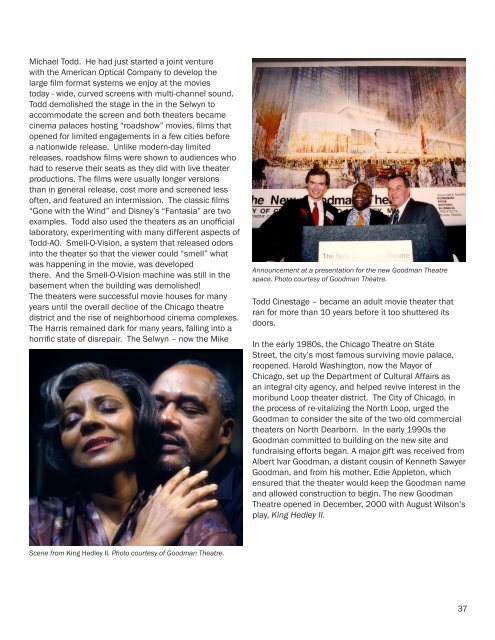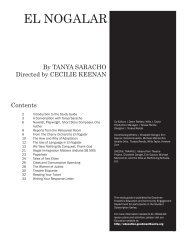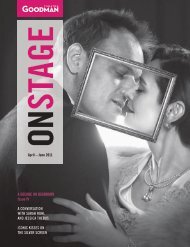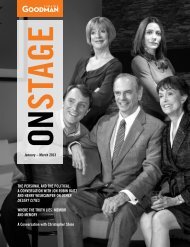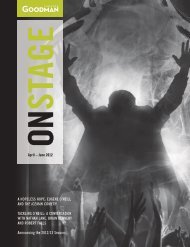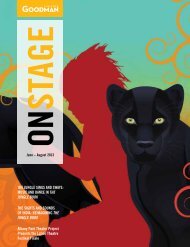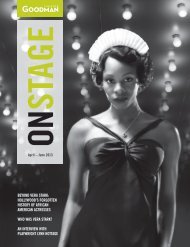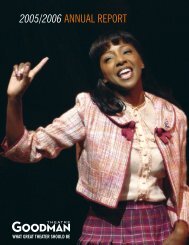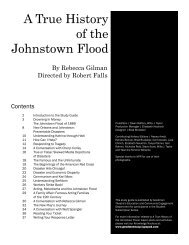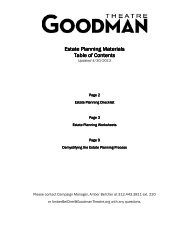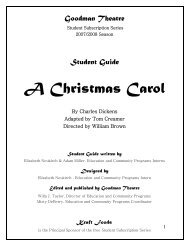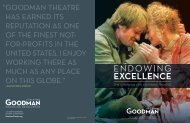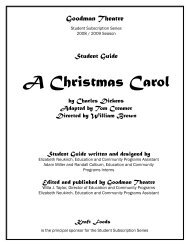The Seagull Study Guide (12MB) - Goodman Theatre
The Seagull Study Guide (12MB) - Goodman Theatre
The Seagull Study Guide (12MB) - Goodman Theatre
You also want an ePaper? Increase the reach of your titles
YUMPU automatically turns print PDFs into web optimized ePapers that Google loves.
Michael Todd. He had just started a joint venture<br />
with the American Optical Company to develop the<br />
large film format systems we enjoy at the movies<br />
today - wide, curved screens with multi-channel sound.<br />
Todd demolished the stage in the in the Selwyn to<br />
accommodate the screen and both theaters became<br />
cinema palaces hosting “roadshow” movies, films that<br />
opened for limited engagements in a few cities before<br />
a nationwide release. Unlike modern-day limited<br />
releases, roadshow films were shown to audiences who<br />
had to reserve their seats as they did with live theater<br />
productions. <strong>The</strong> films were usually longer versions<br />
than in general release, cost more and screened less<br />
often, and featured an intermission. <strong>The</strong> classic films<br />
“Gone with the Wind” and Disney’s “Fantasia” are two<br />
examples. Todd also used the theaters as an unofficial<br />
laboratory, experimenting with many different aspects of<br />
Todd-AO. Smell-O-Vision, a system that released odors<br />
into the theater so that the viewer could “smell” what<br />
was happening in the movie, was developed<br />
there. And the Smell-O-Vision machine was still in the<br />
basement when the building was demolished!<br />
<strong>The</strong> theaters were successful movie houses for many<br />
years until the overall decline of the Chicago theatre<br />
district and the rise of neighborhood cinema complexes.<br />
<strong>The</strong> Harris remained dark for many years, falling into a<br />
horrific state of disrepair. <strong>The</strong> Selwyn – now the Mike<br />
Announcement at a presentation for the new <strong>Goodman</strong> <strong>The</strong>atre<br />
space. Photo courtesy of <strong>Goodman</strong> <strong>The</strong>atre.<br />
Todd Cinestage – became an adult movie theater that<br />
ran for more than 10 years before it too shuttered its<br />
doors.<br />
In the early 1980s, the Chicago <strong>The</strong>atre on State<br />
Street, the city’s most famous surviving movie palace,<br />
reopened. Harold Washington, now the Mayor of<br />
Chicago, set up the Department of Cultural Affairs as<br />
an integral city agency, and helped revive interest in the<br />
moribund Loop theater district. <strong>The</strong> City of Chicago, in<br />
the process of re-vitalizing the North Loop, urged the<br />
<strong>Goodman</strong> to consider the site of the two old commercial<br />
theaters on North Dearborn. In the early 1990s the<br />
<strong>Goodman</strong> committed to building on the new site and<br />
fundraising efforts began. A major gift was received from<br />
Albert Ivar <strong>Goodman</strong>, a distant cousin of Kenneth Sawyer<br />
<strong>Goodman</strong>, and from his mother, Edie Appleton, which<br />
ensured that the theater would keep the <strong>Goodman</strong> name<br />
and allowed construction to begin. <strong>The</strong> new <strong>Goodman</strong><br />
<strong>The</strong>atre opened in December, 2000 with August Wilson’s<br />
play, King Hedley II.<br />
Scene from King Hedley II. Photo courtesy of <strong>Goodman</strong> <strong>The</strong>atre.<br />
37


